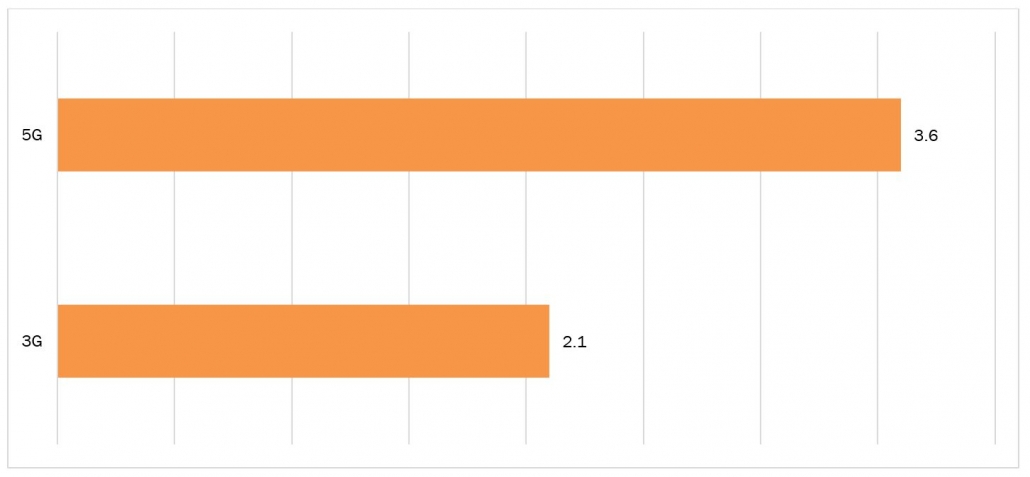Enhancing Connectivity: The Interplay of Dynamic Spectrum Sharing and 5G Technology
Dynamic Spectrum Sharing operates on the principle of dividing access and reallocating spectrum. Access splitting entails a Dynamic Spectrum Sharing-enabled base station supporting multiple access technologies simultaneously, such as 4G LTE and 5G New Radio. Re-farming involves the base station assigning users to a specific frequency band based on network conditions and traffic load. The sophisticated software algorithms in Dynamic Spectrum Sharing enable the base station to analyze traffic load and user characteristics, dynamically adjusting spectrum allocation. This innovative technology facilitates the coexistence of both older 4G LTE users and newer 5G NR users. Additionally, it enables the dynamic allocation of throughput and data rates to optimize overall performance, aligning with user and network requirements.
In the context of NR (New Radio), frequency bands catering to high-speed and high-capacity services are categorized into three main groups. The first category comprises a low-frequency band below 3 GHz, primarily utilized by LTE services and predominantly operating in a frequency division duplex (FDD) method. Following this, there is the mid-frequency band (mid-band) spanning from 3 GHz to 5 GHz. Lastly, the mmWave frequency band (mmWave-band) is situated between 24-40 GHz. Both the mid-band and mmWave-bands operate using time division duplex (TDD). Typically, NR is co-deployed alongside LTE sites, making use of existing LTE infrastructure. In a scenario where NR exclusively utilizes mid-band TDD carriers (with low bands reserved for LTE), it would experience greater propagation and penetration losses compared to the use of low-band FDD carriers. This inherent limitation of the mid-band frequency leads to reduced coverage, especially in the uplink (UL) transmission, resulting in coverage gaps. Figure 3 illustrates the coverage gaps that would be present in the hypothetical situation where NR operates solely on mid-band. The indoor coverage gap is a direct consequence of penetration loss in the mid-band frequency. Additionally, it’s noteworthy that the reduction in coverage is more pronounced in mmWave-band TDD carriers.
Dynamic Spectrum Sharing (DSS) facilitates adaptable resource management aligned with the penetration of NR (New Radio) User Equipment (UE) and the demand for NR traffic, ensuring optimal spectrum utilization. In the early stages of the NR market, the traffic demand for NR may not be substantial enough to necessitate the full utilization of available resources in the re-farmed band. Consequently, there is a risk of underutilization of resources in the re-farmed band that could be otherwise utilized for LTE traffic. Essentially, as long as LTE traffic predominates the market, some resources may remain unused.
However, DSS addresses this challenge by dynamically allocating resources based on traffic demands between LTE and NR throughout the entire spectrum. This feature requires coordination between LTE and NR schedulers, facilitating the exchange of traffic and resource-sharing status and the synchronized dynamic assignment of available resources. Through this sophisticated coordination, LTE resource allocation increases while NR resource allocation decreases during LTE traffic peaks, and vice versa during NR traffic peaks. This dynamic resource allocation accommodates instantaneous bursts in NR traffic, even in the early stages of the NR market, as well as the steady growth in NR demand over time as NR becomes mainstream.
Dynamic Spectrum not only expedites the expansion of 5G but also introduces new benefits for LTE users. The more efficient allocation and optimized utilization of frequencies results in an enhanced overall user experience for LTE users. The LTE band 1 at 2.1 gigahertz (GHz) plays a unique role in this context, having been previously utilized for 3G/UMTS. Through Deutsche Telekom’s 5G booster initiative, 15 megahertz from this frequency band have been utilized since June 2020 for LTE and 5G, dynamically dividing the spectrum. 5G is not a standalone network but is integrated into the 4G cell to enhance overall capacity. Aside from operating at the 2.1 GHz frequency, 5G also utilizes the 3.6 GHz frequency, which is presently allocated for use in major cities. This allocation decision is based on the characteristics of radio frequencies. The 2.1 GHz frequency facilitates long-range coverage at high speeds, making it well-suited for the expansion of 5G in broader areas. On the other hand, the 3.6 GHz frequency achieves exceptionally high data rates but over a shorter range, hence its application in metropolitan areas. The synergy between Dynamic Spectrum Sharing and the expansion of specific sites on the 3.6 GHz frequency band is a key factor contributing to the implementation of the new 5G standard.
Figure 1: Frequency of LTE Bands For 3G and 5G, in Gigahertz

Source: Deutsche Telekom
According to a research paper published by PubMed Central in June 2021, the adoption of DSS technology offers significant advantages, notably cost reduction for mobile operators and optimization of spectrum usage. This is attributed to the mobile network operator’s ability to reuse the existing 15 MHz bandwidth of LTE, eliminating the need to acquire additional dedicated 15 MHz for 5G services. In essence, deploying DSS technology proves beneficial, particularly during the initial rollout of 5G NR, as it allows operators to formulate strategies while presenting an initial 5G landscape to consumers using the already-in-use LTE spectrum.
Brazil’s National Telecommunications Agency (Agencia Nacional de Telecomunicacoes, Anatel) reported that as of December 31, 2021, the mobile operators in the country collectively reached a total of 1.210 million 5G subscriptions utilizing dynamic spectrum sharing (DSS) technology. DSS facilitates the simultaneous operation of 4G and 5G services within a single frequency band.
In the 3GPP Release 15, the introduction of a feature known as 5G DSS (Dynamic Spectrum Sharing) eliminates the necessity for refarming, significantly expediting the transition to 5G. DSS capitalizes on the commonality that both 4G LTE and 5G NR share OFDM technology and introduces techniques enabling these waveforms to coexist seamlessly within the same spectrum. Essentially, DSS enables the simultaneous presence of 4G LTE and 5G NR users in the same frequency band or channel, allowing an operator’s base stations and network to dynamically allocate channel resources between 4G and 5G users at each cell site. Consequently, 5G DSS transforms practically any band currently used for 4G LTE into a band ready for immediate 5G deployment. This feature is typically implemented in lower sub-6 GHz frequencies, offering superior 5G coverage compared to higher-frequency 5G bands. Furthermore, it provides additional capacity for 5G without the substantial delays associated with a more prolonged refarming process. While DSS introduces additional overhead to support the operation of 4G and 5G in the same band, the advantages of utilizing DSS for a gradual spectrum transition outweigh the impact on capacity.
On February 18, 2020, ZTE Corporation, a prominent global provider of telecommunications, enterprise, and consumer technology solutions for the Mobile Internet, introduced its SuperDSS solution. This solution stands out as an industry-leading approach to tri-RAT (Radio Access Technology) dynamic spectrum sharing. It represents a significant innovation within the 5G era, advancing the capabilities of the Magic Radio Pro solution to enable multi-RAT spectrum sharing when repurposing legacy FDD (Frequency Division Duplex) bands for 5G deployment. SuperDSS is designed for dynamic spectrum sharing encompassing 2G/4G/5G and 3G/4G/5G, making it an efficient means for rapid 5G deployment. Simultaneously, it facilitates the provision of legacy voice services over the 1800MHz or 2100MHz bands, ensuring optimal spectrum return on investment.
In April 2020, Nokia revealed the expansion of its AirScale portfolio through various innovative products aimed at meeting the changing requirements of 5G networks and enabling mobile operators to fully leverage the capabilities of 5G. This expansion involves the introduction of a Dynamic Spectrum Sharing (DSS) software upgrade applicable to existing Nokia AirScale base stations and the Nokia AirScale All-in-Cloud base station. This upgrade is designed to enhance network efficiency.
On April 13, 2022, Samsung Electronics Co., Ltd. and Virgin Media O2 jointly announced the successful implementation of multiple operational 4G and 5G sites in the United Kingdom, marking a significant progression in their collaborative efforts. Concurrently with this deployment, the companies achieved the inaugural 5G data call on Virgin Media O2’s commercial 5G network using these sites. Furthermore, the field tests conducted confirmed the interoperability between Virgin Media O2’s 2G/3G/4G networks and Samsung’s latest 4G and 5G solutions. The tests also validated the potential utilization of Samsung’s Dynamic Spectrum Sharing (DSS) capabilities.
In summary, Dynamic Spectrum Sharing represents an advanced communication technology that enhances spectral efficiency, minimizes interference, and creates new spectrum opportunities. While there are challenges to address, Dynamic Spectrum Sharing technologies bring innovation and increased capabilities to various applications, including 5G deployments, IoT services, broadband, and mobile network services. As 5G networks are rolled out, Dynamic Spectrum Sharing is poised to play a crucial role in spectrum reallocation processes, ensuring the optimal utilization of spectrum resources across low-band, mid-band, and mmWave frequencies.
Find some of our related studies:
- 5G SDN Market: https://www.knowledge-sourcing.com/report/5g-sdn-market
- 5G System Integration Market: https://www.knowledge-sourcing.com/report/5g-system-integration-market
- 5G Network Security Market: https://www.knowledge-sourcing.com/report/5g-network-security-market



